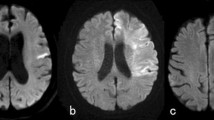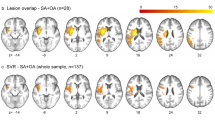Abstract
Speech and swallowing utilize overlapping anatomy and are thus inherently related processes. We sought to identify common neural mechanisms between risk of swallowing dysfunction and apraxia of speech (AOS). This was a retrospective analysis using data from a prospectively collected cohort. Left hemisphere stroke patients (68 subjects) tested with the Apraxia Battery for Adults II, a swallow screen, and MRI were included in the study. Main outcome measure was the presence of AOS or aspiration risk after stroke. We identified a significant association between AOS measures and increased aspiration risk (defined by failed swallow screen; p = 0.04; OR 5.2). Lesions in pars opercularis of Broca’s area (BA 44) were associated with both AOS (p = 0.044; OR 9.7) and increased aspiration risk (p = 0.04; OR 5) but deficits rarely co-occurred in the same cases. Lesions in left premotor cortex (BA 6) were not significantly associated with increased aspiration risk (p = 0.06; OR 3.3) but were significantly associated with AOS (p = 0.008; OR 7). Impaired swallowing function was also associated with lesions in Wernicke’s area (BA 22; p = 0.05; OR 3.5) and pars triangularis (BA 45; p = 0.02; OR 6.8). AOS and risk of aspiration are associated in patients with acute left hemisphere stroke. Acute infarct in the pars opercularis of Broca’s area is associated with both deficits, though they rarely co-occur in the same individual. The co-occurrence of AOS and risk of aspiration likely reflects dependence on closely related neural structures.
Similar content being viewed by others
References
Hamdy S, Mikulis DJ, Crawley A, Xue S, Lau H, Henry S, Diamant NE. Cortical activation during human volitional swallowing: an event-related fMRI study. Am J Physiol Gastrointest Liver Physiol. 1999;277:G219–25.
Mosier KM, Liu WC, Maldjian JA, Shah R, Modi B. Lateralization of cortical function in swallowing: a functional MR imaging study. AJNR Am J Neuroradiol. 1999;20:1520–6.
Hamdy S, Rothwell JC, Brooks DJ, Bailey D, Aziz Q, Thompson DG. Identification of the cerebral loci processing human swallowing with H2(15)O PET activation. J Neurophysiol. 1999;81:1917–26.
Fellows LK, Heberlein AS, Morales DA, Shivde G, Waller S, Wu DH. Method matters: an empirical study of impact in cognitive neuroscience. J Cogn Neurosci. 2005;17:850–8.
Schoenfeld MA, Noesselt T, Poggel D, Tempelmann C, Hopf J, Woldorff MG, Heinze H, Hillyard SA. Analysis of pathways mediating preserved vision after striate cortex lesions. Ann Neurol. 2002;52:814–24.
Robertson LC, Knight RT, Rafal R, Shimamura AP. Cognitive neuropsychology is more than single-case studies. J Exp Psychol. 1993;19(3):710–7.
Mann G, Hankey GJ, Cameron D. Swallowing disorders following acute stroke: prevalence and diagnostic accuracy. Cerebrovasc Dis. 2000;10:380–6.
Cola MG, Daniels SK, Corey DM, Lemen LC, Romero M, Foundas AL. Relevance of subcortical stroke in dysphagia. Stroke. 2010;41:482–6.
Paciaroni M, Mazzotta G, Corea F, Caso V, Venti M, Milia P, Silvestrelli G, Palmerini F, Parnetti L, Gallai V. Dysphagia following Stroke. Eur Neurol. 2004;51:162–7.
Daniels SK, Foundas AL, Iglesia GC, Sullivan MA. Lesion site in unilateral stroke patients with dysphagia. Cerebrovasc Dis. 1996;6:30–4.
Daniels SK, Foundas AL. The role of the insular cortex in dysphagia. Dysphagia. 1997;12:146–56.
Robbins J, Levine RL. Swallowing after unilateral stroke of the cerebral cortex: preliminary experience. Dysphagia. 1988;3:11–7.
Robbins J, Levine RL, Maser A, Rosenbek JC, Kempster GB. Swallowing after unilateral stroke of the cerebral cortex. Arch Phys Med Rehabil. 1993;74:1295–300.
Daniels SK. Swallowing apraxia: a disorder of the Praxis system? Dysphagia. 2000;15:159–66.
Dronkers NF. A new brain region for coordinating speech articulation. Nature. 1996;384:159.
Hillis AE, Work M, Barker PB, Jacobs MA, Breese EL, Maurer K. Re-examining the brain regions crucial for orchestrating speech articulation. Brain. 2004;127:1479–87.
Trupe LA, Varma DD, Gomez Y, Race D, Leigh R, Hillis AE, Gottesman RF. Chronic apraxia of speech and Broca’s area. Stroke. 2013;44:740–4.
DePippo KL, Holas MA, Reding MJ. Validation of the 3-oz water swallow test for aspiration following stroke. Arch Neurol. 1992;49:1259–61.
Suiter DM, Leder SB. Clinical utility of the 3-ounce water swallow test. Dysphagia. 2008;23:244–50.
Dabul BL. Apraxia battery for adults. Austin: Pro-ed; 2000.
Damasio H, Damasio AR. Lesion analysis in neuropsychology. Oxford: Oxford University Press; 1989.
Gonzalez-Fernandez M, Kleinman JT, Ky PK, Palmer JB, Hillis AE. Supratentorial regions of acute ischemia associated with clinically important swallowing disorders: a pilot study. Stroke. 2008;39:3022–8.
Dunn JF, Wu Y, Zhao Z, Srinivasan S, Natah SS. Training the brain to survive stroke. J Stroke Cerebrovasc Dis. 2012;7:e45108.
Gottesman RF, Kleinman JT, Davis C, Heidler-Gary J, Newhart M, Kannan V, Hillis AE. Unilateral neglect is more severe and common in older patients with right hemispheric stroke. Neurology. 2008;71:1439–44.
Gottesman RF, Bahrainwala Z, Wityk RJ, Hillis AE. Neglect is more common and severe at extreme hemoglobin levels in right hemispheric stroke. Stroke. 2010;41:1641–5.
Colak G, Filiano AJ, Johnson GV. The application of permanent middle cerebral artery ligation in the mouse. J Vis Exp. 2011. https://doi.org/10.3791/3039.
Josephs KA, Duffy JR, Strand EA, Whitwell JL, Layton KF, Parisi JE, Hauser MF, Witte RJ, Boeve BF, Knopman DS. Clinicopathological and imaging correlates of progressive aphasia and apraxia of speech. Brain. 2006;129:1385–98.
Mohr JP, Pessin MS, Finkelstein S, Funkenstein HH, Duncan GW, Davis KR. Broca aphasia: pathologic and clinical. Neurology. 1978;28:311–24.
Richardson JD, Fillmore P, Rorden C, LaPointe LL, Fridriksson J. Re-establishing Broca’s initial findings. Brain Lang. 2012;123:125–30.
Ogar J, Willock S, Baldo J, Wilkins D, Ludy C, Dronkers N. Clinical and anatomical correlates of apraxia of speech. Brain Lang. 2006;97:343–50.
Kodumuri N, Sebastian R, Davis C, Posner J, Kim EH, Tippett DC, Wright A, Hillis AE. The association of insular stroke with lesion. 2016;11:41–5.
Teismann IK, Suntrup S, Warnecke T, Steinsträter O, Fischer M, Flöel A, Ringelstein EB, Pantev C, Dziewas R. Cortical swallowing processing in early subacute stroke. BMC Neurol. 2011;11:34.
Acknowledgements
The research reported in this paper was supported by the National Institutes of Health (National Institute of Deafness and Communication Disorders) through Awards DC05375 and K23DC01156. The content is solely the responsibility of the authors and does not necessarily represent the views of the National Institutes of Health.
Author information
Authors and Affiliations
Corresponding author
Ethics declarations
Conflict of interest
The authors have no conflict of interest to disclose.
Rights and permissions
About this article
Cite this article
Trupe, L.A., Mulheren, R.W., Tippett, D. et al. Neural Mechanisms of Swallowing Dysfunction and Apraxia of Speech in Acute Stroke. Dysphagia 33, 610–615 (2018). https://doi.org/10.1007/s00455-018-9879-6
Received:
Accepted:
Published:
Issue Date:
DOI: https://doi.org/10.1007/s00455-018-9879-6




